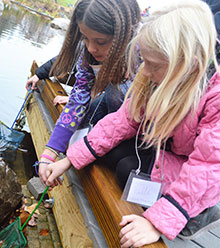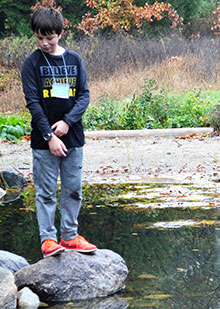Fourth-graders had one task when they visited the pond behind the Wittenbach/Wege Environmental Agriscience Center building for a lesson in species adaptation: “If it’s alive and it’s moving,” naturalist Joanna Szawarski said, “put it in the cup.”
That was all the direction Szawarski’s group needed to fan out with empty containers around the pond, which has been undergoing an expansion and renovation since the spring.
Clutching small nets, they climbed onto boulders, lay on their stomachs atop an observation deck and hop-scotched a path of flat rocks alongside the water in search of whatever swam, wiggled or jumped.
“Look what I found!” shouted Faith Rogers as she pulled her net from the water.
Related Article: What’s in the Water? Students Wade in to Learn – Southeast Kelloggsville teacher Lynnea Roon lifted up a vial containing water that had turned a bright blue, taken from a portion of Buck Creek that flows through the schoolyard. “That’s a lot of phosphate!” a fifth-grader observed. Next she showed a vial of water tested for nitrates that had turned a light shade of pink. “It’s not crazy bright red, so that’s good,” Roon said. On a recent sunny fall day, fifth-grade students trudged along the squishy creek…

“What is it?” shouted back her partner, Saphyre Knowlten.
“I have no idea!” Faith answered.
It might not have been the first time Faith and the worm-like creature she snared had met.
Beginning on Earth Day, April 22, Saphyre and Faith, along with nearly 100 other then third-graders, helped relocate as many residents of the pond to holding tanks as they could. In two days, they and a crew of naturalists helped dig an expansion that more than doubled the original pond’s 750 square feet.
Grants Fund Work
The new pond boasts several natural features for education programs and sustainability, thanks to private donations and an $8,100 grant from the Lowell Area Community Foundation to install a liner and infrastructure such as native plants, boulders and stepping stones.
Bioswales also were created to channel rainwater from the center building’s roofto the pond, which is aerated by a windmill. A bog, or wetland garden, includes native plants such as marsh marigold, cardinal flower and horse mint; and a “pollination station” will encourage bird habitat and honey bees.
Center Director Courtney Cheers said high school natural resources students will create interactive plant tags with QR codes that tell visitors why specific plants were selected and how they will aid wildlife.

An observation deck was constructed by Lowell High School student Elliot Johnson, and bioswale bridges and trail decking by Forest Hills student Daniel Durocher. Both projects were undertaken to earn Eagle Scout badges.
A recent grant from the Lowell Education Foundation will pay for supplies to aid in student lessons.
Teacher Joseph Audia paused beside a children’s swimming pool to help Garrett Nowak identify a bug he’d scooped up and into the pool as a water boatman. He marveled as Garrett and the rest of his students investigated the pond.
“They get so much science and social studies when they’re here,” Audia said, “and it’s different every year. (The Center) is just such a gift to this community.”
CONNECT











